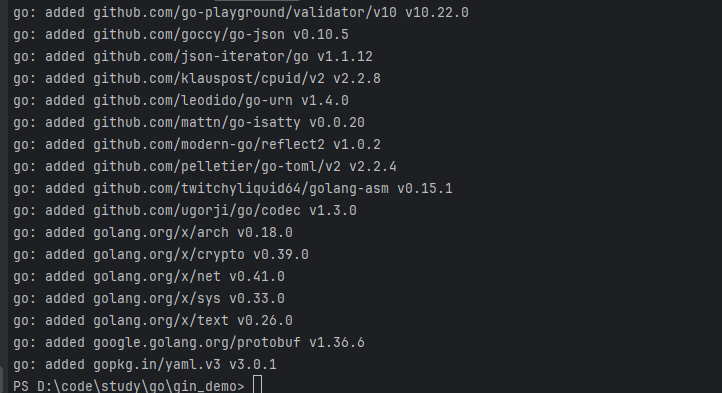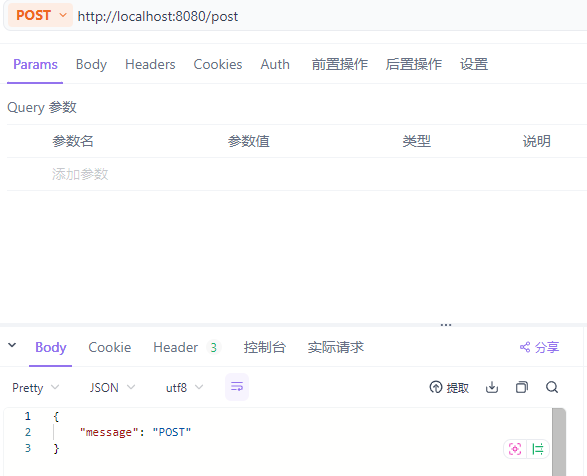Gin框架的基本使用
下载与安装
更改环境变量 GOPATH
方便将包下载到其他的盘符目录
下载
go get -u github.com/gin-gonic/gin
基础使用
GET请求
package main
import "github.com/gin-gonic/gin"
func main() {
router := gin.Default()
router.GET("/ping", func(c *gin.Context) {
c.JSON(200, gin.H{
"message": "Hello World!",
})
})
router.Run() // 监听并在 0.0.0.0:8080 上启动服务
// 默认是在8080端口启动服务,如果8080端口被占用,则自动寻找可用端口启动服务,可以指定端口
}
ANY请求
根据请求来选择(使用if else)
// Any 请求
router.Any("/any", func(c *gin.Context) {
if c.Request.Method == "POST" {
c.JSON(200, gin.H{
"message": "POST",
})
} else if c.Request.Method == "GET" {
c.JSON(200, gin.H{
"message": "GET",
})
} else {
c.JSON(200, gin.H{
"message": "Any",
})
}
})POST请求
// POST 请求
router.POST("/post", func(c *gin.Context) {
c.JSON(200, gin.H{
"message": "POST",
})
})
参数获取
获取query string 参数
格式:URL ?后携带参数
例如:/user/searcher?username=xxx&address=xxx
// 获取参数,query string
router.GET("/user/search", func(c *gin.Context) {
username := c.DefaultQuery("username", "lihuibear")
address := c.Query("address")
// 返回json数据
c.JSON(200, gin.H{
"username": username,
"address": address,
})
})
获取 form参数
当前端请求的数据通过form表单提交时,例如向/user/search发送一个POST请求,获取请求数据的方式如下:
router.POST("/user/search_by_form", func(c *gin.Context) {
// DefaultPostForm取不到值时会返回指定的默认值
//username := c.DefaultPostForm("username", "小王子")
username := c.PostForm("username")
address := c.PostForm("address")
//输出json结果给调用方
c.JSON(http.StatusOK, gin.H{
"message": "ok",
"username": username,
"address": address,
})
})获取JSON参数
当前端请求的数据通过JSON提交时,例如向/json发送一个JSON格式的POST请求,则获取请求参数的方式如下:
//获取JSON参数
router.POST("/json", func(c *gin.Context) {
// 注意:下面为了举例子方便,暂时忽略了错误处理
b, _ := c.GetRawData() // 从c.Request.Body读取请求数据
// 定义map或结构体
var m map[string]interface{}
// 反序列化
_ = json.Unmarshal(b, &m)
c.JSON(http.StatusOK, m)
})获取path参数
请求的参数通过URL路径传递,例如:/user/search/小王子/沙河。 获取请求URL路径中的参数的方式如下:
// 获取path参数
router.GET("/user/search/:username/:address", func(c *gin.Context) {
username := c.Param("username")
address := c.Param("address")
//输出json结果给调用方
c.JSON(http.StatusOK, gin.H{
"message": "ok",
"username": username,
"address": address,
})
})参数绑定 ShouldBind()
为了能够更方便的获取请求相关参数,提高开发效率,我们可以基于请求的Content-Type识别请求数据类型并利用反射机制自动提取请求中QueryString、form表单、JSON、XML等参数到结构体中。
// 参数绑定
// 绑定JSON的示例 ({"user": "q1mi", "password": "123456"})
router.POST("/login_by_JSON", func(c *gin.Context) {
var login Login
if err := c.ShouldBind(&login); err == nil {
fmt.Printf("login info:%#v\n", login)
c.JSON(http.StatusOK, gin.H{
"user": login.User,
"password": login.Password,
})
} else {
c.JSON(http.StatusBadRequest, gin.H{"error": err.Error()})
}
})
// 绑定form表单示例 (user=q1mi&password=123456)
router.POST("/login_by_form", func(c *gin.Context) {
var login Login
// ShouldBind()会根据请求的Content-Type自行选择绑定器
if err := c.ShouldBind(&login); err == nil {
c.JSON(http.StatusOK, gin.H{
"user": login.User,
"password": login.Password,
})
} else {
c.JSON(http.StatusBadRequest, gin.H{"error": err.Error()})
}
})
// 绑定QueryString示例 (/loginQuery?user=q1mi&password=123456)
router.GET("/login_by_query", func(c *gin.Context) {
var login Login
// ShouldBind()会根据请求的Content-Type自行选择绑定器
if err := c.ShouldBind(&login); err == nil {
c.JSON(http.StatusOK, gin.H{
"user": login.User,
"password": login.Password,
})
} else {
c.JSON(http.StatusBadRequest, gin.H{"error": err.Error()})
}
})ShouldBind会按照下面的顺序解析请求中的数据完成绑定:
- 如果是
GET请求,只使用Form绑定引擎(query)。 - 如果是
POST请求,首先检查content-type是否为JSON或XML,然后再使用Form(form-data)。
Gin渲染
我们首先定义一个存放模板文件的templates文件夹,然后在其内部按照业务分别定义一个posts文件夹和一个users文件夹。 posts/index.html文件的内容如下:
<!DOCTYPE html>
<html lang="en">
<head>
<meta charset="UTF-8">
<meta name="viewport" content="width=device-width, initial-scale=1.0">
<meta http-equiv="X-UA-Compatible" content="ie=edge">
<title>posts/index</title>
</head>
<body>
{{.title}}
</body>
</html>
{{end}}users/index.html文件的内容如下:
{{define "users/index.html"}}
<!DOCTYPE html>
<html lang="en">
<head>
<meta charset="UTF-8">
<meta name="viewport" content="width=device-width, initial-scale=1.0">
<meta http-equiv="X-UA-Compatible" content="ie=edge">
<title>users/index</title>
</head>
<body>
{{.title}}
</body>
</html>
{{end}}Gin框架中使用LoadHTMLGlob()或者LoadHTMLFiles()方法进行HTML模板渲染。
func main() {
r := gin.Default()
r.LoadHTMLGlob("templates/**/*")
//r.LoadHTMLFiles("templates/posts/index.html", "templates/users/index.html")
r.GET("/posts/index", func(c *gin.Context) {
c.HTML(http.StatusOK, "posts/index.html", gin.H{
"title": "posts/index",
})
})
r.GET("users/index", func(c *gin.Context) {
c.HTML(http.StatusOK, "users/index.html", gin.H{
"title": "users/index",
})
})
r.Run(":8080")
}文件上传
单文件上传
// 加载模板
router.LoadHTMLFiles("./templates/upload.html")
// 上传文件
router.GET("/upload", func(c *gin.Context) {
c.HTML(http.StatusOK, "upload.html", nil)
})
router.POST("/upload", func(c *gin.Context) {
// 接收用户上传文件的post请求
f, err := c.FormFile("avatar")
if err != nil {
c.JSON(http.StatusInternalServerError, gin.H{
"message": err.Error(),
})
return
}
// 保存到指定目录 dst
dst := "./upload/" + f.Filename
c.SaveUploadedFile(f, dst)
// 返回响应
c.JSON(http.StatusOK, gin.H{
"message": fmt.Sprintf("'%s' uploaded!", f.Filename),
})
})多文件上传
// 多文件上传
// 加载模板
router.LoadHTMLFiles("./templates/uploads.html")
// 显示多文件上传页面
router.GET("/multi-upload", func(c *gin.Context) {
c.HTML(http.StatusOK, "uploads.html", nil)
})
// 多文件上传
router.POST("/multi-upload", func(c *gin.Context) {
// Multipart form
form, err := c.MultipartForm()
if err != nil {
c.JSON(http.StatusBadRequest, gin.H{"error": "failed to parse multipart form"})
return
}
files := form.File["file"]
for index, file := range files {
log.Println(file.Filename)
dst := fmt.Sprintf("./upload/%s_%d", file.Filename, index)
if err := c.SaveUploadedFile(file, dst); err != nil {
c.JSON(http.StatusInternalServerError, gin.H{"error": err.Error()})
return
}
}
c.JSON(http.StatusOK, gin.H{
"message": fmt.Sprintf("%d files uploaded!", len(files)),
})
})重定向
http重定向
// http 重定向
router.GET("/abc", func(c *gin.Context) {
c.Redirect(http.StatusMovedPermanently, "http://www.baidu.com/")
})路由重定向
// 路由重定向
router.GET("/def", func(c *gin.Context) {
c.Request.URL.Path = "/ping"
router.HandleContext(c)
})Gin路由
普通路由
r.GET("/index", func(c *gin.Context) {...})
r.GET("/login", func(c *gin.Context) {...})
r.POST("/login", func(c *gin.Context) {...})any
r.Any("/test", func(c *gin.Context) {...})404页面
r.NoRoute(func(c *gin.Context) {
c.HTML(http.StatusNotFound, "views/404.html", nil)
})路由组
我们可以将拥有共同URL前缀的路由划分为一个路由组。习惯性一对{}包裹同组的路由,这只是为了看着清晰,你用不用{}包裹功能上没什么区别。
func main() {
r := gin.Default()
userGroup := r.Group("/user")
{
userGroup.GET("/index", func(c *gin.Context) {...})
userGroup.GET("/login", func(c *gin.Context) {...})
userGroup.POST("/login", func(c *gin.Context) {...})
}
shopGroup := r.Group("/shop")
{
shopGroup.GET("/index", func(c *gin.Context) {...})
shopGroup.GET("/cart", func(c *gin.Context) {...})
shopGroup.POST("/checkout", func(c *gin.Context) {...})
}
r.Run()
}路由组也是支持嵌套的,例如:
shopGroup := r.Group("/shop")
{
shopGroup.GET("/index", func(c *gin.Context) {...})
shopGroup.GET("/cart", func(c *gin.Context) {...})
shopGroup.POST("/checkout", func(c *gin.Context) {...})
// 嵌套路由组
xx := shopGroup.Group("xx")
xx.GET("/oo", func(c *gin.Context) {...})
}通常我们将路由分组用在划分业务逻辑或划分API版本时。
路由原理
Gin框架中的路由使用的是httprouter这个库。
其基本原理就是构造一个路由地址的前缀树。
Gin中间件
Gin框架允许开发者在处理请求的过程中,加入用户自己的钩子(Hook)函数。这个钩子函数就叫中间件,中间件适合处理一些公共的业务逻辑,比如登录认证、权限校验、数据分页、记录日志、耗时统计等。
定义中间件
Gin中的中间件必须是一个gin.HandlerFunc类型。
记录接口耗时的中间件
例如我们像下面的代码一样定义一个统计请求耗时的中间件。
// StatCost 是一个统计耗时请求耗时的中间件
func StatCost() gin.HandlerFunc {
return func(c *gin.Context) {
start := time.Now()
c.Set("name", "小王子") // 可以通过c.Set在请求上下文中设置值,后续的处理函数能够取到该值
// 调用该请求的剩余处理程序
c.Next()
// 不调用该请求的剩余处理程序
// c.Abort()
// 计算耗时
cost := time.Since(start)
log.Println(cost)
}
}记录响应体的中间件
我们有时候可能会想要记录下某些情况下返回给客户端的响应数据,这个时候就可以编写一个中间件来搞定。
type bodyLogWriter struct {
gin.ResponseWriter // 嵌入gin框架ResponseWriter
body *bytes.Buffer // 我们记录用的response
}
// Write 写入响应体数据
func (w bodyLogWriter) Write(b []byte) (int, error) {
w.body.Write(b) // 我们记录一份
return w.ResponseWriter.Write(b) // 真正写入响应
}
// ginBodyLogMiddleware 一个记录返回给客户端响应体的中间件
// https://stackoverflow.com/questions/38501325/how-to-log-response-body-in-gin
func ginBodyLogMiddleware(c *gin.Context) {
blw := &bodyLogWriter{body: bytes.NewBuffer([]byte{}), ResponseWriter: c.Writer}
c.Writer = blw // 使用我们自定义的类型替换默认的
c.Next() // 执行业务逻辑
fmt.Println("Response body: " + blw.body.String()) // 事后按需记录返回的响应
}跨域中间件cors
推荐使用社区的https://github.com/gin-contrib/cors 库,一行代码解决前后端分离架构下的跨域问题。
注意: 该中间件需要注册在业务处理函数前面。
这个库支持各种常用的配置项,具体使用方法如下。
package main
import (
"time"
"github.com/gin-contrib/cors"
"github.com/gin-gonic/gin"
)
func main() {
router := gin.Default()
// CORS for https://foo.com and https://github.com origins, allowing:
// - PUT and PATCH methods
// - Origin header
// - Credentials share
// - Preflight requests cached for 12 hours
router.Use(cors.New(cors.Config{
AllowOrigins: []string{"https://foo.com"}, // 允许跨域发来请求的网站
AllowMethods: []string{"GET", "POST", "PUT", "DELETE", "OPTIONS"}, // 允许的请求方法
AllowHeaders: []string{"Origin", "Authorization", "Content-Type"},
ExposeHeaders: []string{"Content-Length"},
AllowCredentials: true,
AllowOriginFunc: func(origin string) bool { // 自定义过滤源站的方法
return origin == "https://github.com"
},
MaxAge: 12 * time.Hour,
}))
router.Run()
}当然你可以简单的像下面的示例代码那样使用默认配置,允许所有的跨域请求。
func main() {
router := gin.Default()
// same as
// config := cors.DefaultConfig()
// config.AllowAllOrigins = true
// router.Use(cors.New(config))
router.Use(cors.Default())
router.Run()
}注册中间件
在gin框架中,我们可以为每个路由添加任意数量的中间件。
为全局路由注册
func main() {
// 新建一个没有任何默认中间件的路由
r := gin.New()
// 注册一个全局中间件
r.Use(StatCost())
r.GET("/test", func(c *gin.Context) {
name := c.MustGet("name").(string) // 从上下文取值
log.Println(name)
c.JSON(http.StatusOK, gin.H{
"message": "Hello world!",
})
})
r.Run()
}为某个路由单独注册
// 给/test2路由单独注册中间件(可注册多个)
r.GET("/test2", StatCost(), func(c *gin.Context) {
name := c.MustGet("name").(string) // 从上下文取值
log.Println(name)
c.JSON(http.StatusOK, gin.H{
"message": "Hello world!",
})
})为路由组注册中间件
为路由组注册中间件有以下两种写法。
写法1:
shopGroup := r.Group("/shop", StatCost())
{
shopGroup.GET("/index", func(c *gin.Context) {...})
...
}写法2:
shopGroup := r.Group("/shop")
shopGroup.Use(StatCost())
{
shopGroup.GET("/index", func(c *gin.Context) {...})
...
}中间件注意事项
gin默认中间件
gin.Default()默认使用了Logger和Recovery中间件,其中:
Logger中间件将日志写入gin.DefaultWriter,即使配置了GIN_MODE=release。Recovery中间件会recover任何panic。如果有panic的话,会写入500响应码。
如果不想使用上面两个默认的中间件,可以使用gin.New()新建一个没有任何默认中间件的路由。
gin中间件中使用goroutine
当在中间件或handler中启动新的goroutine时,不能使用原始的上下文(c *gin.Context),必须使用其只读副本(c.Copy())。
运行多个服务
我们可以在多个端口启动服务,例如:
package main
import (
"log"
"net/http"
"time"
"github.com/gin-gonic/gin"
"golang.org/x/sync/errgroup"
)
var (
g errgroup.Group
)
func router01() http.Handler {
e := gin.New()
e.Use(gin.Recovery())
e.GET("/", func(c *gin.Context) {
c.JSON(
http.StatusOK,
gin.H{
"code": http.StatusOK,
"error": "Welcome server 01",
},
)
})
return e
}
func router02() http.Handler {
e := gin.New()
e.Use(gin.Recovery())
e.GET("/", func(c *gin.Context) {
c.JSON(
http.StatusOK,
gin.H{
"code": http.StatusOK,
"error": "Welcome server 02",
},
)
})
return e
}
func main() {
server01 := &http.Server{
Addr: ":8080",
Handler: router01(),
ReadTimeout: 5 * time.Second,
WriteTimeout: 10 * time.Second,
}
server02 := &http.Server{
Addr: ":8081",
Handler: router02(),
ReadTimeout: 5 * time.Second,
WriteTimeout: 10 * time.Second,
}
// 借助errgroup.Group或者自行开启两个goroutine分别启动两个服务
g.Go(func() error {
return server01.ListenAndServe()
})
g.Go(func() error {
return server02.ListenAndServe()
})
if err := g.Wait(); err != nil {
log.Fatal(err)
}
}